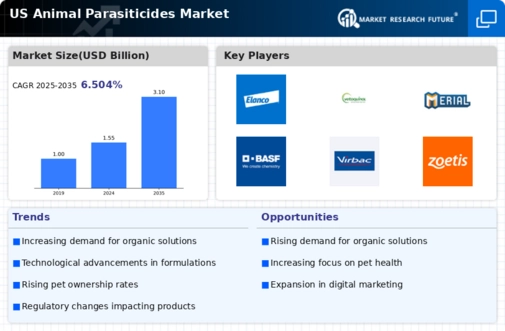The US Animal Parasiticides Market plays a crucial role in the broader context of animal health and veterinary care, particularly in addressing the growing challenges posed by parasites in both companion and livestock animals. The competitive landscape is characterized by a diverse range of players, including both established companies and emerging firms that are actively developing innovative solutions to cater to the demands of a dynamic marketplace. Factors such as increasing awareness about pet health, rising incidences of parasitic infections, and the overall growth in the animal husbandry sector are driving market expansion.
Companies are focusing on research and development to introduce new formulations and delivery methods, ensuring they meet regulatory standards while providing effective solutions. The interplay between market share, product effectiveness, and marketing strategies shapes the competitive interactions within the market, illustrating a complex environment driven by both technological advancements and consumer preferences.Elanco has a strong presence in the US Animal Parasiticides Market, leveraging its extensive portfolio and expertise in animal health. The company emphasizes innovation and customer engagement, which positions it well in the competitive landscape.
Its strengths lie in its reputation for high-quality products, backed by significant investment in research and development. Elanco has successfully addressed various parasitic challenges through its effective parasite control solutions, gaining a loyal customer base among veterinary practitioners and pet owners. The company has also pursued strategic partnerships and collaborations, enhancing its market position and enabling timely responses to evolving market needs in veterinary care.
This strategic focus has facilitated Elanco's ability to launch new and effective products, thereby reinforcing its competitive edge.Bayer Animal Health is another significant player within the US Animal Parasiticides Market, recognized for its comprehensive range of products and services aimed at preventing and treating parasitic infections in animals. The company has established a strong foothold in the market with a diverse product lineup that includes innovative parasiticides targeting both internal and external parasites. Bayer's strengths lie in its commitment to research, leading to the development of advanced solutions that meet the demands of veterinarians and pet owners alike.
The company's strategic mergers and acquisitions have further bolstered its product offerings and market share, allowing it to access new technologies and expand its reach. Bayer's focus on sustainability and responsible use of veterinary products resonates well with consumers, strengthening brand loyalty and enhancing its competitive standing in the US market. Such initiatives keep Bayer at the forefront of the industry, positioning it as a key player dedicated to addressing the challenges posed by animal parasites in a rapidly evolving marketplace.






















